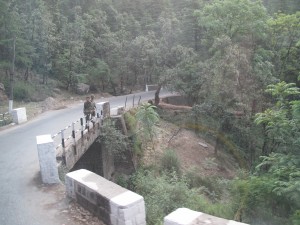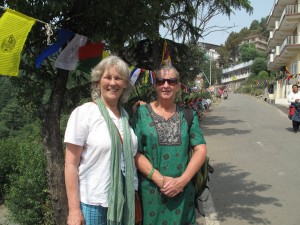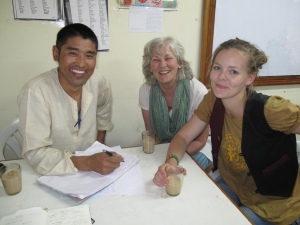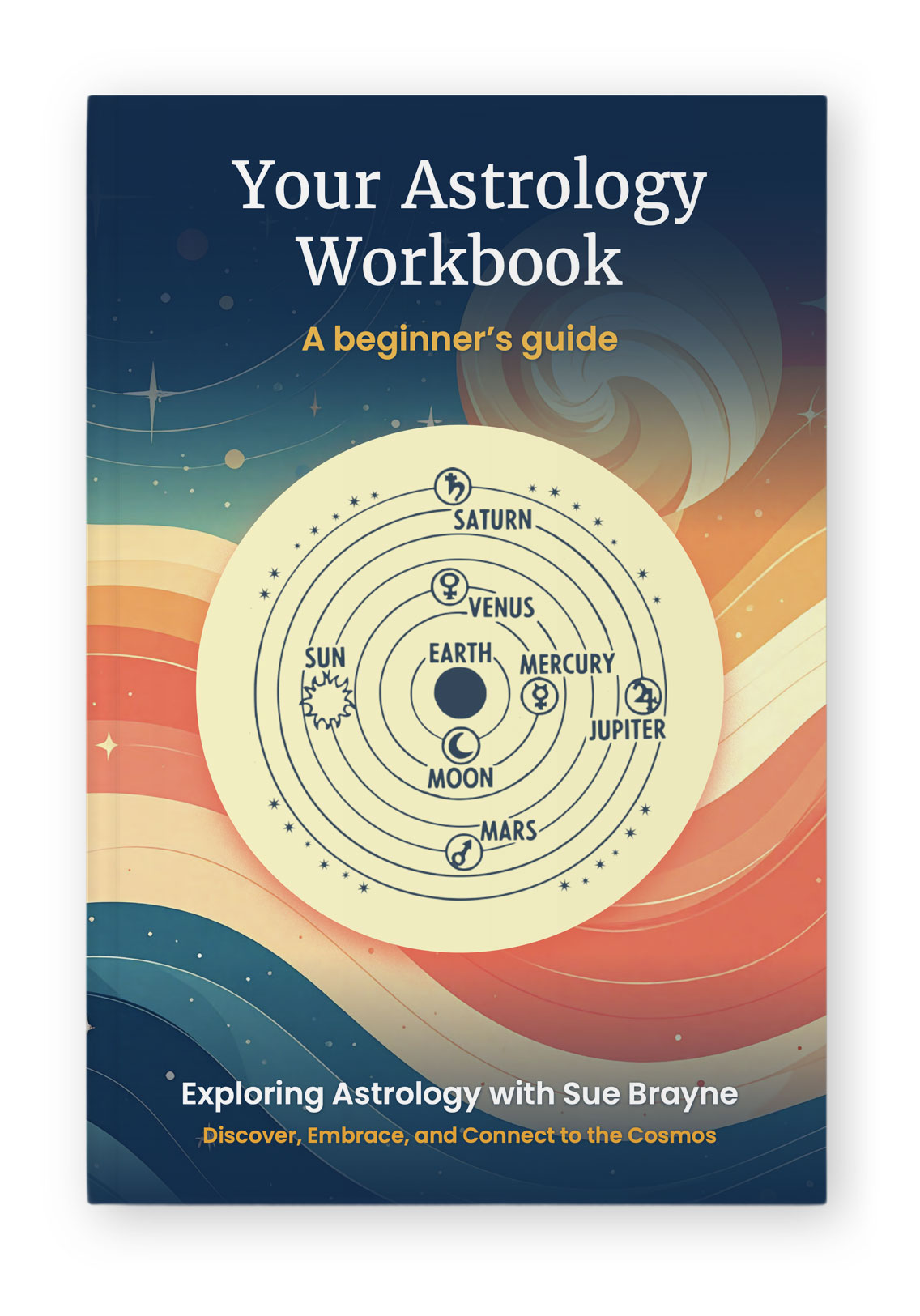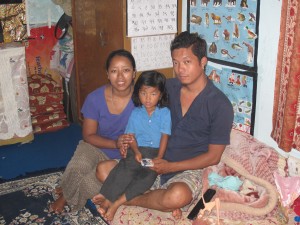
What with settling in with my home-stay family in McLeod Ganj (similar in size and vibe to what I image Kathmandu to be) and finding my feet teaching Tibetan monks, you could say these past few days have been one hell of a learning curve.
I am staying with Payma and her husband Nyima, and their little minx of a daughter, Tenzin Zompa.
Both Payma and Nyima speak surprisingly good English, learnt at school, and they have made me feel very welcome.
The one-storey house is made of concrete, as are most of the houses. It has a kitchen and two small rooms which act as bedrooms-cum-living-areas. They don’t have chairs, but use low couches that double up for sitting and sleeping. You just chuck a blanket over you at night and curl up on the Tibetan rug (probably made in China) that covers the couch. All Tibetans do this.

Payma and Nyima’s room has the most enormous flat-screen television you’ve ever seen, tuned to the Bollywood movies channel. My room, on the other hand, is dominated by a shrine dedicated to the Dalai Lama.
Just off is a tiled bathroom with a western loo. But there’s no running water at the moment. It has to be collected from a standpipe in large heavy canisters and I sluice myself down using a jug. But after a hot, tiring day, this cold wash-down is as invigorating as standing under the shower at home.
And, I only clean my teeth using precious drinking water.
Water here is a problem. A big problem. In the rainy season it must pour through the valleys, but right now there is barely a trickle. McLeod Ganj is known as a health spa, and I can only imagine how much water is put aside for people who can afford these treats.
As part of the home-stay agreement, Payma gives me breakfast, usually a plain omlette and flat bread. At night, it’s typically a hot chilli vegetable dish accompanied by rice, (occasionally there’s a little meat included), which I am learning to eat with my right hand. At first I made a dreadful mess, but I’m getting the hang of it now, and rather liking it.
The house is part of a tight Tibetan community, so there are always people and children milling about, and the dawn chorus involves quite a lot of spitting, snorting, and coughing. But everyone is full of smiles and I feel quite safe.
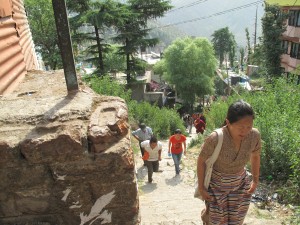
The only drawback is that the house is at the bottom of a series of precarious steps made out of concrete and rock, leading up a steep hill to he main road. This means a laborious climb every morning and several stops to gather breath. The upside is how my fitness is gradually improving.
Teaching the monks is another mighty experience. On the first day, Dawa, our IVHQ Tibetan co-ordinator, gave us volunteer teachers a briefing on what we could expect. The only problem was that his English could do with a bit of a buffing up, so at times it was quite hard to understand exactly what he was saying.

Anyway, I teach three lessons a day. Four and half hours in total.
My first lesson lasting two hours was conducted beneath a tree in a kind of park area with two young Tibetan monks and a Mongolian couple.
I am amazed at how much English they already know, but their accents are simply dreadful, and if you can get a Tibetan and Mongolian to pronounce ‘V’ with any clarity, sign up with IVHQ to teach right away.
Sherab and Rinchen, the two Tibetan monks, told me they were dispatched to the monastery by their parents at the age of nine and ten respectively. Sherab, a thoughtful, quiet twenty-seven-year-old who loves to paint Buddhist Thangkas and read short stories, said that his mother had decided on this particular path for him because he was so small for his age.
For thirty-year-old Rinchen, who is obsessed with basketball (he plays in his robes) and loves to hang out with his friends, it was because his mother couldn’t think of what else to do with him.
I got the impression from both of them that this wasn’t necessarily what they would have wished for themselves, but they had accepted their fate with good grace, and the expectation of reaping good karma in their next incarnation.

My second lesson is with Lobsang Charphel and Lobsang Tenzin, two older monks who live in the Dalai Lama’s temple complex, with very little English between them.
They are utterly delightful and giggle most of the time, especially when I demonstrated the difference between walking, running, limping, and crawling.
They also learnt the words for ‘floor’, ‘ceiling’ and ‘scissors.’ Scissors proved to be a bit of a challenge pronunciation-wise, but they are game for anything.
We also ‘took off our shoes’ and ‘put on our shoes’, and we ‘picked up the toothbrush’ and ‘put down the toothbrush.’ More beaming smiles when they got the hang of that.
My final lesson is with Zorigoo from Mongolia. This is an hour of conversation rather than a full on teaching, so the two of us retired to a café where I ordered a sorely-needed cup of tea.
Zorigoo has a passion for horse riding (Mongolian national pastime) and holds great admiration for his hero, Genghis Khan (he is God in Mongolia). He also told me about Ysuhbayar, the most famous wrestler in the land, who I guess is the equivalent to our David Beckham.
Zoirgoo has come to India with his girlfriend to learn English (not much opportunity in Mongolia) and is passionate about saving the Shonkhor, a small eagle, that the Arabs are capturing in huge numbers for hawking back in their own countries.

After I finished my day, all I could think of was cold beer. So I headed for a lovely café with panoramic views of the snow-capped Himalayas, and remained there enjoying a super-large bottle of Kingfisher beer until it was time to head down those perilous steps to Payma and supper.
My first day working as an English teacher has been a wonderful experience, and I am looking forward to settling in properly. But I am very glad that I do have previous teaching experience, because it’s quite something to be thrown into the deep end without a single teaching resource. Nothing is provided, so you have to think on your feet and improvise.
Certainly my twenty-five-year-old IVHQ colleague who has never taught before found it a huge challenge, particularly when she was ushered into a class of eight monks with only one English grammar book between them.
But this is the adventure we signed up for, and I am thrilled to be here.
I see the challenge ahead as a fantastic opportunity to learn about a way of life that is so completely different from my own in the UK, and to know that teaching is never a one-way street.

